He has starred in movies, is recognized worldwide and is considered one of the most loved, remembered and requested dogs of all time. The
Saint Bernard is a superstar and right now we will understand why.
-
Size : Large/Giant.
-
Weight : Between 54 and 82kg.
-
Hair type : Medium, straight and dense.
-
Character : Friendly, Vivacious, Vigilant, Gentle, Calm
-
Health : Prone to bone and joint problems
-
Life expectancy : Between 8 and 10 years.
Due to his
large size and his furry and friendly appearance , he has become a highly sought-after dog. Many videos and photos of puppies and adult dogs of this breed adorn the internet and it is inevitable to love them.
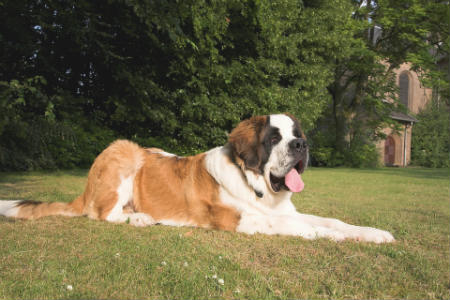
In addition to their imposing look and size, Saint Bernards will always be remembered for the small barrel that hung from their neck where they carried liquor or medicine for their owners or human companions when they were rescued in the mountains long ago. Now, this animal
is considered a very faithful and protective dog , which conquers everyone with sweetness and affection.
History and origin of the Saint Bernard
This
wonderful breed originated in the Swiss Alps and Northern Italy, where the Romans settled with their different types of dogs, which when mixed, found this wonderful dog. Among the dogs that gave rise to the Saint Bernard were the now extinct Alpine Mastiff,
the Tibet Doge , the Great Dane and the
Newfoundland . For several centuries, starting in the 17th century specifically, these breeds mixed with each other until obtaining what this breed is today. The canines that gave rise to the Saint Bernard were used as surveillance, bodyguard and rescue dogs in the 11th century by a group of monks who ran a hospice
in the pass of Mount Saint Bernard , which had the purpose of providing accommodation and protection to pilgrims, travelers and visitors.
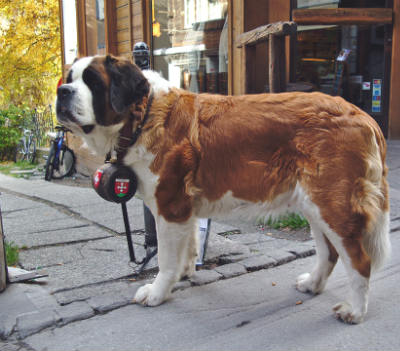
With the passage of time, and thanks to their strength, courage and tenacity,
the Saint Bernards became very useful . Their presence was required as companions for those crossing the mountain, since they could provide great help in case of an accident. Currently,
the Saint Bernard has been officially designated as the Swiss National Dog , thanks to all the work it has done as a rescue dog. Nowadays, it is easier to see it in a field in a city due to its large size. Likewise, it is no longer so common to see him rescuing people, but rather as
proud and loved members of a family .
Physical characteristics of the Saint Bernard
The Saint Bernard
is a dog with a large and imposing build . It can be very tall, big and heavy, so it needs to have a lot of space to move around. They have a good-natured appearance, which denotes great nobility. Among all the aspects that may catch our attention about a Saint Bernard, the head undoubtedly stands out, especially due to its particular features. The head of a Saint Bernard is wide and large, with deep-set, medium-sized eyes that vary in color, from light to dark brown. Their nostrils are normally wide open with a black nose.
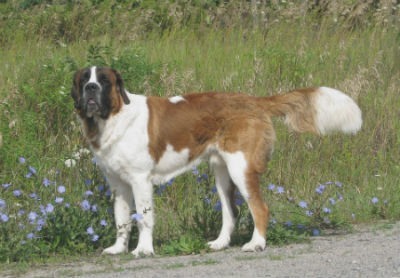
If we talk about their snout and bite, it is usually wide and powerful, since the jaws they have are wide and the same size both above and below. As for its ears, these hang on each side of its head, they are triangular in shape and of medium size. The tail of a Saint Bernard is long and always hanging down, which gives it more agility. Their legs are thick and the legs are usually straight.
Types of coat present in Saint Bernards
It is important to keep in mind that
there are two types of Saint Bernard , one that has short hair and another that has long hair. However, there are no differences between these two types, apart from the length of their hair and color, since both have the same dimensions and the same temperament.
-
Short-haired Saint Bernard : It has straight, dense hair all over the outside of its body, and on the inside, it has thick, short fur on the sides. In addition, the tail of the short hair is usually thick and bushy, and it has a fringe on its legs.
-
Long-haired Saint Bernard : If we refer to the fur on its outer layer, it is medium-sized and smooth, and internally it also has thick fur. In some cases, the fur that covers the hip may be of the wavy type. The tail has a large amount of thick and dense hair. The extremities also have bangs, but with greater abundance.

Saint Bernard Coat Color
Regardless of the type of hair they have, the specimens of this breed have the same range of colors. They are mostly white with red, brown, and sometimes yellow or cream spots. These spots appear in a variety of sizes between each specimen and in some cases they cover a large part of the outer layer of the Saint Bernard. But, normally, these dogs have a predominance of white, especially in their inner coats. There is also the possibility that there are Saint Bernard specimens with black spots, although these do not usually occur frequently.
Dimensions of the Saint Bernard
Normally there are not many differences in size between male and female Saint Bernard specimens, except for their height. For the rest,
it will depend on the individual characteristics of the dog and its diet .
-
Height : Males 70cm / Females: 65cm minimum.
-
Weight : Oscillates between 60kg and 90kg.
Saint Bernard Temperament
Although
the Saint Bernard is a dog that can become quite large and corpulent , it is not characterized by being violent. In reality
, he is a very affectionate and friendly dog . He can be described as extroverted and, in fact,
he greatly enjoys the company of children , to whom he usually cares and gives a lot of love. The Saint Bernard is a very loyal dog, with rather slow movements and a tendency to be quite patient. It is very rare to hear of a specimen of this breed that has attacked someone, as they tend to be calm, good dogs if they are properly educated,
they will always try to help their masters , whom they adore with passion. Although it enjoys and needs exercise, like any other dog, the Saint Bernard is not a dog that is constantly active and is not characterized by wasting energy. Rather, they tend to enjoy long, quiet walks, as well as lying down at their master's feet to rest.
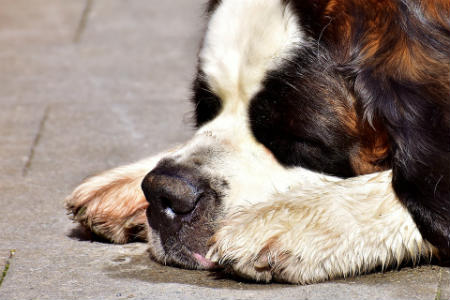
It could be said that Saint Bernards even become more passive as they age, so care must be taken to ensure that their diet is always appropriate, as they have a tendency to gain weight and then it is difficult to make them lose weight, especially when they are already more adults are found. Although
the Saint Bernard adores his master with great devotion , he does not have a tendency toward extreme dependence and also enjoys being alone, which is why he can become independent and look for ways to distract himself. Even so, it will require attention, Saint Bernards love to live with people, and that is why
it is often considered a family dog .
Life expectancy of the Saint Bernard
The Saint Bernard is a beautiful and large dog that will give us its love and affection for an estimated time of between 8 and 10 years, which will vary depending on diet, exercise and if any disease occurs that may affect its health.
Saint Bernard Care
There are certain diseases that can occur in a Saint Bernard throughout their life, and although this does not mean that they will certainly suffer from them, there is a tendency for this to happen. Among them are the following:
- Hip or elbow dysplasia
- stomach twist
- Dilated cardiomyopathy (so special attention must be paid when given any type of sedative, as this can be fatal)
To prevent most of these diseases, it is important, again, to take care of its diet by following a diet recommended by an expert veterinarian who knows how to provide the appropriate and necessary amounts for the dog. You can take a look at our catalog to see the specific food we have.

Daily exercise should also be added to your diet, which will provide mobility and agility to your muscles, and will facilitate the burning of fat, which is so important to avoid being overweight. But this should be done in moderation, since stomach torsion can result from excessive training. Apart from this care, there is one that is very relevant in a Saint Bernard, and that is taking care of its head. As we well know, the head is one of its most outstanding characteristics, so it is important that, especially in long-haired specimens, the secretions that emanate from their eyes are constantly cleaned, because, as they age, Over the years, moderate detachments usually occur between the skin and the eyes. The Saint Bernard tends to drool a lot, so you must keep in mind that
oral hygiene care must be continuous, having to be done periodically. As for brushing, it is recommended that a simple brush be done daily and a complete and deep brushing every 8 or 10 weeks.
Education and training of the Saint Bernard
This is a dog that in many cases is considered a “giant dog”, so one of the big problems that arise when training or educating it is its size and the amount of space it requires. Therefore, it is always advisable to start as soon as possible, before it reaches a size that makes the process difficult, since when it is a puppy and small, it can be better and more manageable. Like any other dog,
it is important that you start interacting with other dogs , animals or humans as soon as possible when you are a puppy, because, having a large size, it is necessary for you to quickly learn to deal with others.
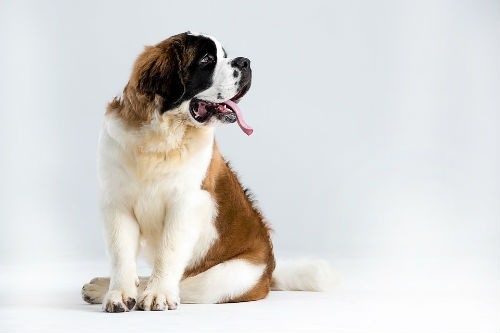
It is also important to remember that the space you have for it to develop must be large since, being such a large dog, it requires enough space for it to have mobility that allows it to feel comfortable.
The Saint Bernard responds very well to positive reinforcement training , making it very easy to train him and make him become obedient.
Saint Bernard Prices
It is very easy
to acquire a Saint Bernard puppy , you can get them from professional breeders, in a store or online; so their prices vary depending on the place where you want to make the purchase. The recommendation is to be very attentive to the breeding conditions that the seller has, since many times these are not the most appropriate or ethical. If it has a pedigree, of course the price is usually higher. In dollars it can range between 3,000 and 3,500 dollars
for a Pedigree Saint Bernard puppy , a price that in euros is equivalent to 2,600 and 3,000.
To take into account
The Saint Bernard
is one of the cutest, most affectionate and beloved giant breed dogs in the world. His incredible temperament and how he can care for children with such devotion is known worldwide. He is undoubtedly a family dog if he is introduced to interacting with other people, dogs or animals in time. Especially so that they grow up having a sense of “prudence” necessary when interacting with animals or people smaller than themselves.
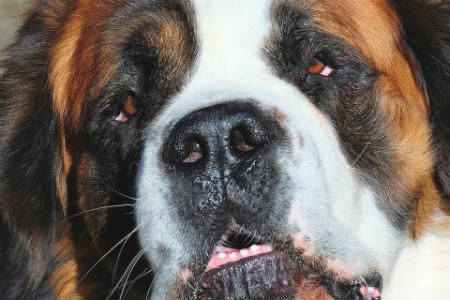
He can be very calm, and in fact a little slow in movements. As he grows, he becomes more and more passive, and that can be a point in his favor if we appreciate tranquility, but it is something to take into account if we do not want him to become overweight. The Saint Bernard is, without a doubt, a dog that needs us to really know what we are getting into when we decide to introduce it into our lives. The best thing is to know every aspect they have and then weigh whether we have the space, strength and dedication to be with them.
We also recommend these other articles:
 In addition to their imposing look and size, Saint Bernards will always be remembered for the small barrel that hung from their neck where they carried liquor or medicine for their owners or human companions when they were rescued in the mountains long ago. Now, this animal is considered a very faithful and protective dog , which conquers everyone with sweetness and affection.
In addition to their imposing look and size, Saint Bernards will always be remembered for the small barrel that hung from their neck where they carried liquor or medicine for their owners or human companions when they were rescued in the mountains long ago. Now, this animal is considered a very faithful and protective dog , which conquers everyone with sweetness and affection.
 With the passage of time, and thanks to their strength, courage and tenacity, the Saint Bernards became very useful . Their presence was required as companions for those crossing the mountain, since they could provide great help in case of an accident. Currently, the Saint Bernard has been officially designated as the Swiss National Dog , thanks to all the work it has done as a rescue dog. Nowadays, it is easier to see it in a field in a city due to its large size. Likewise, it is no longer so common to see him rescuing people, but rather as proud and loved members of a family .
With the passage of time, and thanks to their strength, courage and tenacity, the Saint Bernards became very useful . Their presence was required as companions for those crossing the mountain, since they could provide great help in case of an accident. Currently, the Saint Bernard has been officially designated as the Swiss National Dog , thanks to all the work it has done as a rescue dog. Nowadays, it is easier to see it in a field in a city due to its large size. Likewise, it is no longer so common to see him rescuing people, but rather as proud and loved members of a family .
 If we talk about their snout and bite, it is usually wide and powerful, since the jaws they have are wide and the same size both above and below. As for its ears, these hang on each side of its head, they are triangular in shape and of medium size. The tail of a Saint Bernard is long and always hanging down, which gives it more agility. Their legs are thick and the legs are usually straight.
If we talk about their snout and bite, it is usually wide and powerful, since the jaws they have are wide and the same size both above and below. As for its ears, these hang on each side of its head, they are triangular in shape and of medium size. The tail of a Saint Bernard is long and always hanging down, which gives it more agility. Their legs are thick and the legs are usually straight.

 It could be said that Saint Bernards even become more passive as they age, so care must be taken to ensure that their diet is always appropriate, as they have a tendency to gain weight and then it is difficult to make them lose weight, especially when they are already more adults are found. Although the Saint Bernard adores his master with great devotion , he does not have a tendency toward extreme dependence and also enjoys being alone, which is why he can become independent and look for ways to distract himself. Even so, it will require attention, Saint Bernards love to live with people, and that is why it is often considered a family dog .
It could be said that Saint Bernards even become more passive as they age, so care must be taken to ensure that their diet is always appropriate, as they have a tendency to gain weight and then it is difficult to make them lose weight, especially when they are already more adults are found. Although the Saint Bernard adores his master with great devotion , he does not have a tendency toward extreme dependence and also enjoys being alone, which is why he can become independent and look for ways to distract himself. Even so, it will require attention, Saint Bernards love to live with people, and that is why it is often considered a family dog .
 Daily exercise should also be added to your diet, which will provide mobility and agility to your muscles, and will facilitate the burning of fat, which is so important to avoid being overweight. But this should be done in moderation, since stomach torsion can result from excessive training. Apart from this care, there is one that is very relevant in a Saint Bernard, and that is taking care of its head. As we well know, the head is one of its most outstanding characteristics, so it is important that, especially in long-haired specimens, the secretions that emanate from their eyes are constantly cleaned, because, as they age, Over the years, moderate detachments usually occur between the skin and the eyes. The Saint Bernard tends to drool a lot, so you must keep in mind that oral hygiene care must be continuous, having to be done periodically. As for brushing, it is recommended that a simple brush be done daily and a complete and deep brushing every 8 or 10 weeks.
Daily exercise should also be added to your diet, which will provide mobility and agility to your muscles, and will facilitate the burning of fat, which is so important to avoid being overweight. But this should be done in moderation, since stomach torsion can result from excessive training. Apart from this care, there is one that is very relevant in a Saint Bernard, and that is taking care of its head. As we well know, the head is one of its most outstanding characteristics, so it is important that, especially in long-haired specimens, the secretions that emanate from their eyes are constantly cleaned, because, as they age, Over the years, moderate detachments usually occur between the skin and the eyes. The Saint Bernard tends to drool a lot, so you must keep in mind that oral hygiene care must be continuous, having to be done periodically. As for brushing, it is recommended that a simple brush be done daily and a complete and deep brushing every 8 or 10 weeks.
 It is also important to remember that the space you have for it to develop must be large since, being such a large dog, it requires enough space for it to have mobility that allows it to feel comfortable. The Saint Bernard responds very well to positive reinforcement training , making it very easy to train him and make him become obedient.
It is also important to remember that the space you have for it to develop must be large since, being such a large dog, it requires enough space for it to have mobility that allows it to feel comfortable. The Saint Bernard responds very well to positive reinforcement training , making it very easy to train him and make him become obedient.
 He can be very calm, and in fact a little slow in movements. As he grows, he becomes more and more passive, and that can be a point in his favor if we appreciate tranquility, but it is something to take into account if we do not want him to become overweight. The Saint Bernard is, without a doubt, a dog that needs us to really know what we are getting into when we decide to introduce it into our lives. The best thing is to know every aspect they have and then weigh whether we have the space, strength and dedication to be with them.
He can be very calm, and in fact a little slow in movements. As he grows, he becomes more and more passive, and that can be a point in his favor if we appreciate tranquility, but it is something to take into account if we do not want him to become overweight. The Saint Bernard is, without a doubt, a dog that needs us to really know what we are getting into when we decide to introduce it into our lives. The best thing is to know every aspect they have and then weigh whether we have the space, strength and dedication to be with them.












